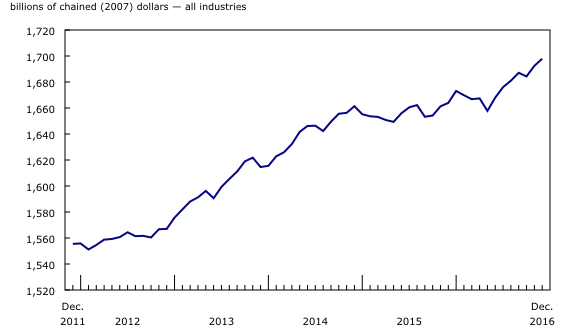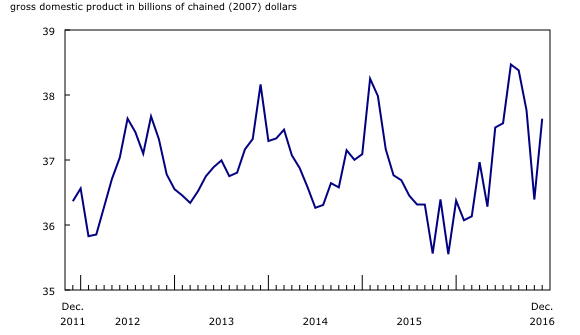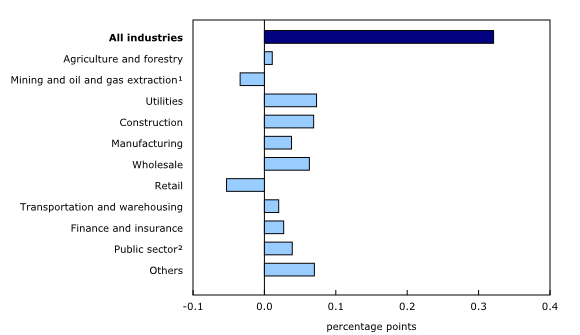Gross domestic product by industry, December 2016
Archived Content
Information identified as archived is provided for reference, research or recordkeeping purposes. It is not subject to the Government of Canada Web Standards and has not been altered or updated since it was archived. Please "contact us" to request a format other than those available.
Released: 2017-03-02
December 2016
0.3% 
(monthly change)
Gross domestic product (GDP) grew 0.3% in December. With the exception of October, GDP has increased every month since June. Utilities, construction and wholesale trade were the main contributors to growth in December.
Goods-producing industries rose for the sixth time in seven months, up 0.5% in December. Service-producing industries were up 0.2%, as the majority of sectors grew.
Utilities sector grows as seasonal weather returns
After three consecutive monthly declines, the utilities sector grew 3.4% in December. Electric power generation, transmission and distribution (+3.3%) and natural gas distribution (+7.3%) both rose as seasonal weather returned across the country in December. In November, unusually warm weather led to lower demand for heating.
Construction expands in December
The construction sector grew 1.0% in December, the third increase in four months following weakness earlier in 2016. After a string of declines since the fourth quarter of 2014, engineering and other construction activities rose 2.0% in December, the largest gain since April 2012. Residential construction rose 0.7%, on higher single and multi-unit dwellings construction. Non-residential construction contracted 0.4%.
Wholesale trade grows
Wholesale trade grew 1.2% in December. The majority of subsectors increased, led by higher wholesaling of machinery, equipment and supplies, petroleum products and food, beverage and tobacco products. The wholesaling of motor vehicles and parts edged down on lower imports and exports.
Manufacturing continues to expand
Manufacturing was up 0.4% in December. With the exception of October, the manufacturing sector's output has risen every month since June 2016.
Durable manufacturing rose 0.7% in December. The gain was led by transportation equipment, which rose 3.4% following three consecutive monthly declines. There were also notable increases in fabricated metal product and miscellaneous manufacturing. Non-metallic mineral product manufacturing was lower, while primary metal manufacturing fell for the third time in four months.
Non-durable manufacturing was essentially unchanged. Results were mixed, as decreases in chemical and food manufacturing were mainly offset by growth in paper manufacturing and petroleum and coal products. Plastics and rubber products manufacturing had higher output for the fourth time in five months.
Finance and insurance advances
Finance and insurance rose 0.4% in December. Financial investment services, funds and other financial vehicles were up 2.0% while insurance carriers and related activities advanced 0.6%. Depository credit intermediation and monetary authorities were unchanged.
Real estate and rental and leasing grows
Real estate and rental and leasing was up 0.3% in December as all subsectors expanded. Offices of real estate agents and brokers posted a 2.7% increase, partially offsetting the 6.4% decline in November following lending rule changes that came into effect in mid-October.
Retail trade declines
Retail trade contracted 1.0% in December after five consecutive monthly gains. All retail trade subsectors declined, with the exception of gasoline stations and building material and garden equipment and supplies dealers (store types not traditionally associated with holiday shopping) and non-store retailers.
Mining, quarrying, and oil and gas extraction contracts
Mining, quarrying, and oil and gas extraction was down 0.4% in December. Oil and gas extraction declined 3.7% on lower conventional oil and gas extraction and non-conventional oil extraction.
Support activities for mining and oil and gas extraction grew 21%, as both oil and gas extraction drilling and rigging services were up. This was the fifth consecutive monthly increase for this subsector after generally declining since the summer of 2014.
Mining and quarrying (except oil and gas) grew 3.1%, mostly as a result of a 16% increase in potash mining. Coal mining expanded 0.6%. Metal ore mining contracted 0.3%, led by declines in copper, nickel, lead and zinc ore mining related to lower exports.
Other industries
The public sector (education, health and public administration combined) was up 0.2% in December as all three components rose.
Transportation and warehousing services rose 0.4%. Air and truck transportation and support activities increased, while rail and pipeline transportation were lower.
Accommodation and food services declined 0.5%, as a result of lower activity at both accommodation and food services and drinking places in December. This sector has been declining since peaking in July.
Fourth quarter of 2016
The value added of goods-producing industries increased 0.8% in the fourth quarter, while that of service-producing industries rose 0.5%.
The rise in the value added of goods-producing industries was driven by gains in mining, quarrying, and oil and gas extraction (+3.3%) and construction (+0.6%). The primary contributors to growth in the mining, quarrying, and oil and gas extraction sector were non-conventional oil extraction (+5.4%) and support activities for mining and oil and gas extraction (+23%), with the latter posting a second quarterly increase after four quarters of declines. In contrast, conventional oil and gas was down 2.4% after three consecutive quarters of growth.
Mining and quarrying (except oil and gas) increased by 4.3%, as a result of growth in non-metallic mining. Following seven consecutive quarterly declines, the construction sector rose 0.6% due to increased residential building construction and repair construction.
Utilities decreased 2.3% following a 3.3% increase the previous quarter, as a result of warmer than usual weather in the summer of 2016 in Eastern and Central Canada. Manufacturing output was essentially unchanged in the fourth quarter.
The main contributors to growth in service-producing industries were real estate and rental and leasing (+0.6%) and the public sector (education, health, and public administration combined), which increased 0.3%. Professional, scientific and technical services rose 1.1%, led by continued growth in computer systems design and related services. Retail trade was up 1.1% after two consecutive quarterly declines, while wholesale trade rose 1.0%.
Annual 2016
The value added of service-producing industries rose 2.1% in 2016, about the same pace as in 2015. The value added of goods-producing industries decreased for a second consecutive year, down 0.8% in 2016.
The largest contributor to the overall decline in goods-producing industries was the construction sector (-3.3%), on lower engineering and non-residential construction.
Mining, quarrying, and oil and gas extraction was down 1.8% due to lower output in support activities for mining and oil and gas extraction, while other subsectors increased.
The agriculture and forestry sector grew 3.3% as a result of higher crop production.
Utilities rose 1.1%, marking the industry's highest annual increase since 2011 on higher electricity generation, transmission and distribution partly due to warmer than usual weather across many parts of Canada in the summer of 2016.
Manufacturing was up 0.6%, as gains in non-durable manufacturing more than offset the overall decline in durable manufacturing.
Real estate and rental and leasing (+3.0%) and finance and insurance (+4.4%) were the largest contributors to growth in service-producing industries in 2016. Public sector industries (education, health and public administration combined) were up 2.0%. There were also notable gains in transportation and warehousing services (+3.0%), retail (+2.3%) and wholesale (+1.5%) trade.

In celebration of the country's 150th birthday, Statistics Canada is presenting snapshots from our rich statistical history.
Today, we take a look back at the history of gross dometic product (GDP) as a means to examine the Canadian economy. The availability of GDP by industry data as a measure of monthly economic production goes back to 1961.
The make-up of the Canadian economy from a GDP by industry perspective has changed significantly since 1961. Good-producing industries accounted for more than 40% of the Canadian economy in 1961. Since 2009, service producing industries have represent about 70% of the Canadian economy.
In 1961, manufacturing (durable and non-durable goods) accounted for more than half of total goods-producing industries GDP. In 2016, 55 years later, manufacturing accounts for approximately one-third of goods-producing industries GDP.
Growth in service-producing industries since 1961 has primarily been in the real estate and rental and leasing sector, and the finance and insurance sector.
Note to readers
Monthly gross domestic product (GDP) by industry data at basic prices are chained volume estimates with 2007 as the reference year. This means that data for each industry and each aggregate are obtained from a chained volume index, multiplied by the industry's value added in 2007. Monthly data are benchmarked to annually chained Fisher volume indexes of GDP obtained from the constant-price supply and use tables (SUT) up to the latest SUT year (2013).
For the period starting with January 2014, data are derived by chaining a fixed-weight Laspeyres volume index to the prior period. The fixed weights are 2013 industry prices.
This approach makes the monthly GDP by industry data more comparable with expenditure-based GDP data, which are chained quarterly.
All data in this release are seasonally adjusted. For information on seasonal adjustment, see Seasonally adjusted data – Frequently asked questions.
For more information on GDP, see the video "What is Gross Domestic Product (GDP)?"
Revisions
With this release of monthly GDP by industry, revisions have been made back to January 2016.
Each month, newly available administrative and survey data from various industries in the economy are integrated and result in statistical revisions. Updated and revised administrative data (including taxation statistics), new information provided by respondents to industry surveys, and standard changes to seasonal adjustment calculations are incorporated with each release.
For more information about monthly national GDP by industry, see the System of Macroeconomic Accounts module on our website.
Real-time CANSIM tables
Real-time CANSIM table 379-8031 will be updated on March 13. For more information, consult the document Real-time CANSIM tables.
Next release
Data on GDP by industry for January will be released on March 31.
Contact information
For more information, contact us (toll-free 1-800-263-1136; 514-283-8300; STATCAN.infostats-infostats.STATCAN@canada.ca).
To enquire about the concepts, methods or data quality of this release, contact Allan Tomas (613-790-6570), Industry Accounts Division.
- Date modified:




